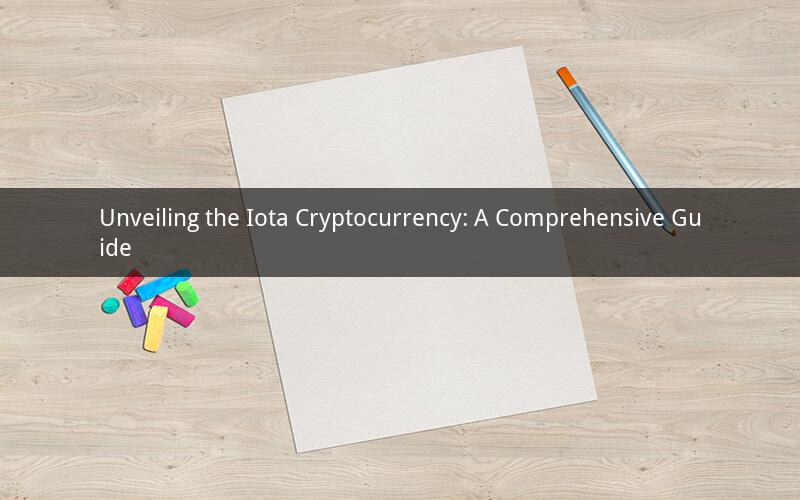
Introduction:
The world of cryptocurrencies is vast and dynamic, with new coins emerging almost daily. One such cryptocurrency that has gained attention is Iota (MIOTA). But what exactly is Iota, and why has it become a topic of interest? This article aims to delve into the origins, technology, and potential future of Iota cryptocurrency.
1. What is Iota?
Iota (MIOTA) is a cryptocurrency designed to facilitate transactions within the Internet of Things (IoT) ecosystem. Unlike traditional cryptocurrencies like Bitcoin, Iota does not rely on a blockchain technology. Instead, it uses a directed acyclic graph (DAG) known as Tangle.
2. The Tangle:
The Tangle is a revolutionary technology that sets Iota apart from other cryptocurrencies. Unlike the blockchain, which requires miners to verify transactions, the Tangle requires users to validate two previous transactions in order to make their own. This consensus mechanism ensures that the network remains secure and decentralized without the need for mining.
3. The Internet of Things:
One of the primary reasons for the creation of Iota was to address the challenges faced by the Internet of Things (IoT) ecosystem. With billions of devices connected to the internet, the need for a secure and scalable transaction system is crucial. Iota aims to enable microtransactions between these devices, making it a potential solution for the IoT's micropayment problem.
4. Advantages of Iota:
There are several advantages to using Iota, including:
- Low transaction fees: Since Iota does not require mining, transaction fees are extremely low, making it an ideal choice for micropayments.
- Scalability: The Tangle allows for a high volume of transactions per second, making Iota scalable for the IoT ecosystem.
- Security: The Tangle's consensus mechanism ensures that the network remains secure and decentralized.
5. Potential Use Cases:
Iota has the potential to revolutionize various industries, including:
- Smart cities: Iota can facilitate transactions between smart city devices, such as parking meters and streetlights.
- Energy sector: Iota can enable peer-to-peer energy trading between devices, such as solar panels and batteries.
- Healthcare: Iota can be used to track and secure medical data, ensuring privacy and security.
6. Challenges and Future Prospects:
Despite its promising potential, Iota faces several challenges:
- Market competition: The cryptocurrency market is highly competitive, and Iota must differentiate itself from other cryptocurrencies.
- Regulatory concerns: Governments around the world are still grappling with how to regulate cryptocurrencies, which could impact Iota's future.
- Scalability concerns: While the Tangle is designed to be scalable, there are concerns about its ability to handle a large number of transactions.
7. Conclusion:
Iota cryptocurrency, with its innovative Tangle technology and focus on the IoT ecosystem, has the potential to revolutionize various industries. However, it faces challenges that must be addressed for it to achieve widespread adoption. As the world continues to embrace the power of cryptocurrencies, it will be interesting to see how Iota evolves and impacts the future of the IoT.
Questions and Answers:
1. What is the difference between Iota and Bitcoin?
Iota is designed for the Internet of Things (IoT) ecosystem and uses a directed acyclic graph (DAG) known as Tangle, while Bitcoin relies on blockchain technology. Iota does not require mining and has extremely low transaction fees.
2. How does the Tangle consensus mechanism work?
The Tangle requires users to validate two previous transactions in order to make their own. This consensus mechanism ensures that the network remains secure and decentralized without the need for mining.
3. What are the potential use cases for Iota?
Iota has the potential to revolutionize various industries, including smart cities, energy sector, and healthcare, by enabling secure and scalable micropayments between devices.
4. What are the main challenges facing Iota?
The main challenges facing Iota include market competition, regulatory concerns, and scalability concerns. The cryptocurrency market is highly competitive, and governments are still grappling with how to regulate cryptocurrencies.
5. How can I purchase Iota?
You can purchase Iota by signing up for a cryptocurrency exchange, such as Binance or Kraken, and then transferring your preferred currency into the exchange. Once you have funds in your exchange account, you can trade for Iota (MIOTA).